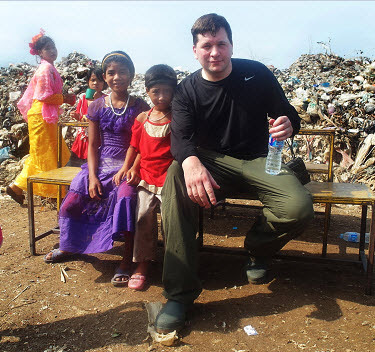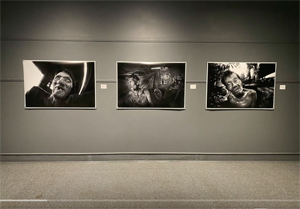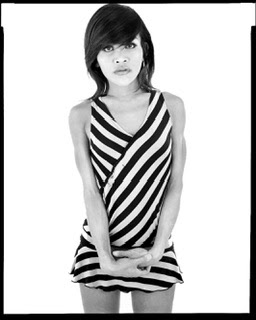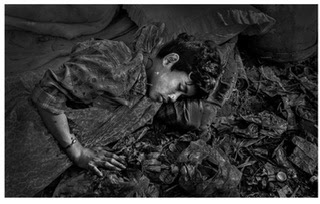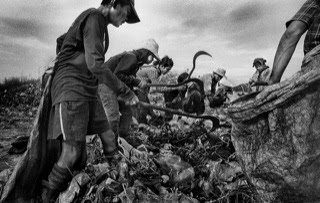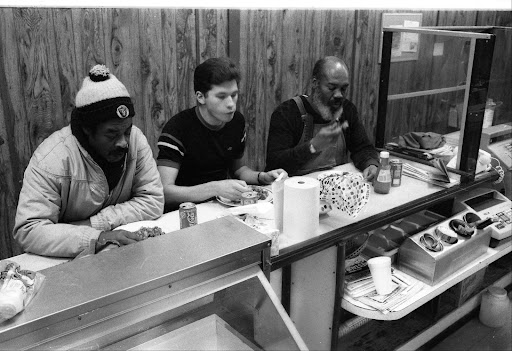- DW......Gerry, as a fellow Canadian I applaud your vision. However, I honestly believe you have to temper your enthusiasm with a big dose of reality. I don't think you have any idea the difficulty working plein air with collodion, let alone something as large as 90 x 90cm! This is only more enhanced because you have yet to pour a plate (as I understand). If you are aspiring to get mobile within the next few years with that Big Brute, I would really encourage you to take a workshop as soon as you can and start learning all the nuances and subtleties of the process with a much smaller format (4x5 inch on start up to keep costs down). I think most will agree that experience in the contemporary darkroom will prove little benefit in the collodion world.Gerry Yaum
 Dale maybe so, but none of that tempering is for me. Sometime it is important to just say f-ck it and go after big dreams otherwise not much ever happens. Photogs are constantly making excuses for why they cannot do stuff. People in general always rationalize why this or that will not work, they sort of fail before they even start. Screw that! I will try and if I fail then that's fine, at least I went down swinging. As to doing large wet plates I have met men who have done such things (spent time in Italy with Kurt Moser) so I know it is doable with enough hard work and determination. Others have done it already so why not me? If I cannot shoot it on wet plate, I will just do it on film in the same darkroom space. I do not want to live with regret. When I am an old old guy and have had my stroke and am pissing into a bag hanging on my wheelchair, I want to be able to look back at my life and say to myself, "I tried! I gave it my all!" Failure is something much easier to deal with than regret.
Dale maybe so, but none of that tempering is for me. Sometime it is important to just say f-ck it and go after big dreams otherwise not much ever happens. Photogs are constantly making excuses for why they cannot do stuff. People in general always rationalize why this or that will not work, they sort of fail before they even start. Screw that! I will try and if I fail then that's fine, at least I went down swinging. As to doing large wet plates I have met men who have done such things (spent time in Italy with Kurt Moser) so I know it is doable with enough hard work and determination. Others have done it already so why not me? If I cannot shoot it on wet plate, I will just do it on film in the same darkroom space. I do not want to live with regret. When I am an old old guy and have had my stroke and am pissing into a bag hanging on my wheelchair, I want to be able to look back at my life and say to myself, "I tried! I gave it my all!" Failure is something much easier to deal with than regret. - Gerry Yaum
 As
to not pouring a plate I have done small tin types, have taken a
workshop and have been involved with photography in general for 41 years
now. I am self taught all the way (except for the wet plate workshop), all the time type guy so technical
things do not really worry me. All that technique stuff can be learned,
it is just a matter of doing it enough times. With the internet I have a
huge advantage as well I can ask my internet friends when I screw up,
in the old days that was impossible, you were 100% on your own. I also
have a back up plan for the large 35x35 camera. I am having reducing
backs made for both film and plates, so if 35x35 is too much to handle
then I can go down to 20x24 plates or if worse comes to worse 20x24
film. Your right of course on your plan of action. I am already heading
down that path. I have already taken a workshop and have studied the
books, videos and basics for quite a few years. I do not plan to start the main
part of KANATA until I am 59 or 60 (I will retire at that age). I am 55
now, so that gives me 4 or 5 years to do basic wet plate stuff on
cameras ranging from 4x5 to 16x20. The reason I got the trailer now was
for that purpose. I will outfit it over the next several months,
recently bought a sink and portable waste tank, buying a generator also.
I will use it in the spring to start shooting smaller ambrotypes and
tintypes. By the time I hit 59-60, all my ducks should be in order. I
will probably not shoot the 35x35 for quite a while after I start the
project. Step by step builds the grand cathedral!! When your self taught
your used to making mistakes and overcoming them, that is my plan now.
As
to not pouring a plate I have done small tin types, have taken a
workshop and have been involved with photography in general for 41 years
now. I am self taught all the way (except for the wet plate workshop), all the time type guy so technical
things do not really worry me. All that technique stuff can be learned,
it is just a matter of doing it enough times. With the internet I have a
huge advantage as well I can ask my internet friends when I screw up,
in the old days that was impossible, you were 100% on your own. I also
have a back up plan for the large 35x35 camera. I am having reducing
backs made for both film and plates, so if 35x35 is too much to handle
then I can go down to 20x24 plates or if worse comes to worse 20x24
film. Your right of course on your plan of action. I am already heading
down that path. I have already taken a workshop and have studied the
books, videos and basics for quite a few years. I do not plan to start the main
part of KANATA until I am 59 or 60 (I will retire at that age). I am 55
now, so that gives me 4 or 5 years to do basic wet plate stuff on
cameras ranging from 4x5 to 16x20. The reason I got the trailer now was
for that purpose. I will outfit it over the next several months,
recently bought a sink and portable waste tank, buying a generator also.
I will use it in the spring to start shooting smaller ambrotypes and
tintypes. By the time I hit 59-60, all my ducks should be in order. I
will probably not shoot the 35x35 for quite a while after I start the
project. Step by step builds the grand cathedral!! When your self taught
your used to making mistakes and overcoming them, that is my plan now. - Gerry Yaum
 Personal photo experiences have also hardened me to the reality that you can accomplish most anything if you have enough desire. If you have the will to do so mountains can be climbed. When I was 21 I photographed drug use (Heroin injecting) in a African American American Ghetto. When I was 32-44 I photographed sex workers in Thailand while speaking a 2nd language (Thai) that I learned for that purpose. At 40-55 I photographed in Thai slums, at 49-55 years old I photographed Burmese refugee's in a garbage dump with flies, cockroaches and the like crawling all over me. All those experiences and meeting so many wonderful people along the way puts life's problems in a proper perspective. The idea of attempting to do large wet plate images in clean/safe/beautiful Canadian nature does not seem all that intimidating to me. If I fail so what, nothing ventured nothing gained. If I succeed then important photographs, photographs that could last hundreds of years and be potentially shown in the National Gallery of Canada could be created. What do I have to lose? Heck I am just a security guard in Edmonton, trying to do something important, if I fail to accomplish my goals, no one will even notice!
Personal photo experiences have also hardened me to the reality that you can accomplish most anything if you have enough desire. If you have the will to do so mountains can be climbed. When I was 21 I photographed drug use (Heroin injecting) in a African American American Ghetto. When I was 32-44 I photographed sex workers in Thailand while speaking a 2nd language (Thai) that I learned for that purpose. At 40-55 I photographed in Thai slums, at 49-55 years old I photographed Burmese refugee's in a garbage dump with flies, cockroaches and the like crawling all over me. All those experiences and meeting so many wonderful people along the way puts life's problems in a proper perspective. The idea of attempting to do large wet plate images in clean/safe/beautiful Canadian nature does not seem all that intimidating to me. If I fail so what, nothing ventured nothing gained. If I succeed then important photographs, photographs that could last hundreds of years and be potentially shown in the National Gallery of Canada could be created. What do I have to lose? Heck I am just a security guard in Edmonton, trying to do something important, if I fail to accomplish my goals, no one will even notice!
- Gerry Yaum
 Here
is the sink. A large stainless sink from a restaurant, got it last week
off. The plan is to have a 15-25 gallon portable waste container hooked
up to the drain and to use camping water jugs for the main water
source. I will also be hooking the faucet to a water supply in
campground settings etc. The trailer darkroom will be used to develop
sheet film as well, maybe do a bit of contact printing for fun (that is
where the furnace comes in). For KANATA I will probably be on the road
for upwards of 3 months at a time so having darkroom that can do a bit
more will be important. I will likely be spending hundreds of hours in
this space. I plan to follow your advice and install an exhaust fan
(found someone who can do that). Will also be putting a platform on the
roof of the trailer allowing for higher camera positions if necessary.
Here
is the sink. A large stainless sink from a restaurant, got it last week
off. The plan is to have a 15-25 gallon portable waste container hooked
up to the drain and to use camping water jugs for the main water
source. I will also be hooking the faucet to a water supply in
campground settings etc. The trailer darkroom will be used to develop
sheet film as well, maybe do a bit of contact printing for fun (that is
where the furnace comes in). For KANATA I will probably be on the road
for upwards of 3 months at a time so having darkroom that can do a bit
more will be important. I will likely be spending hundreds of hours in
this space. I plan to follow your advice and install an exhaust fan
(found someone who can do that). Will also be putting a platform on the
roof of the trailer allowing for higher camera positions if necessary.
Gerry Yaum What
I am most worried about is not the tech stuff but instead, "can I make
strong photos in wet plate?" Personally I feel that (this is just my
opinion please do not get upset you bastards) a high percentage of wet
plate photography is CRAP. The only thing that makes it interesting is
the fact that it is an old school, super cool process. I want and hope
to do more than use a cool process. When you show the work, when you
promote it in the media or at exhibitions, the talk should not be all
wet plate, collodion, salts and gear stuff. Who gives a flying shit
about all of that. What should matter most is the imagery created. Not using the process not for its own sake, but instead using the process to enhance and create important, meaningful art. Kinda mastering (or at least semi kinda mastering) the process part will mostly likely happen. I just hope I can create strong images using it! That is the great unknown, that is frightening.
What
I am most worried about is not the tech stuff but instead, "can I make
strong photos in wet plate?" Personally I feel that (this is just my
opinion please do not get upset you bastards) a high percentage of wet
plate photography is CRAP. The only thing that makes it interesting is
the fact that it is an old school, super cool process. I want and hope
to do more than use a cool process. When you show the work, when you
promote it in the media or at exhibitions, the talk should not be all
wet plate, collodion, salts and gear stuff. Who gives a flying shit
about all of that. What should matter most is the imagery created. Not using the process not for its own sake, but instead using the process to enhance and create important, meaningful art. Kinda mastering (or at least semi kinda mastering) the process part will mostly likely happen. I just hope I can create strong images using it! That is the great unknown, that is frightening.
 What
I am most worried about is not the tech stuff but instead, "can I make
strong photos in wet plate?" Personally I feel that (this is just my
opinion please do not get upset you bastards) a high percentage of wet
plate photography is CRAP. The only thing that makes it interesting is
the fact that it is an old school, super cool process. I want and hope
to do more than use a cool process. When you show the work, when you
promote it in the media or at exhibitions, the talk should not be all
wet plate, collodion, salts and gear stuff. Who gives a flying shit
about all of that. What should matter most is the imagery created. Not using the process not for its own sake, but instead using the process to enhance and create important, meaningful art. Kinda mastering (or at least semi kinda mastering) the process part will mostly likely happen. I just hope I can create strong images using it! That is the great unknown, that is frightening.
What
I am most worried about is not the tech stuff but instead, "can I make
strong photos in wet plate?" Personally I feel that (this is just my
opinion please do not get upset you bastards) a high percentage of wet
plate photography is CRAP. The only thing that makes it interesting is
the fact that it is an old school, super cool process. I want and hope
to do more than use a cool process. When you show the work, when you
promote it in the media or at exhibitions, the talk should not be all
wet plate, collodion, salts and gear stuff. Who gives a flying shit
about all of that. What should matter most is the imagery created. Not using the process not for its own sake, but instead using the process to enhance and create important, meaningful art. Kinda mastering (or at least semi kinda mastering) the process part will mostly likely happen. I just hope I can create strong images using it! That is the great unknown, that is frightening. | |
| New darkroom trailer sink. |









